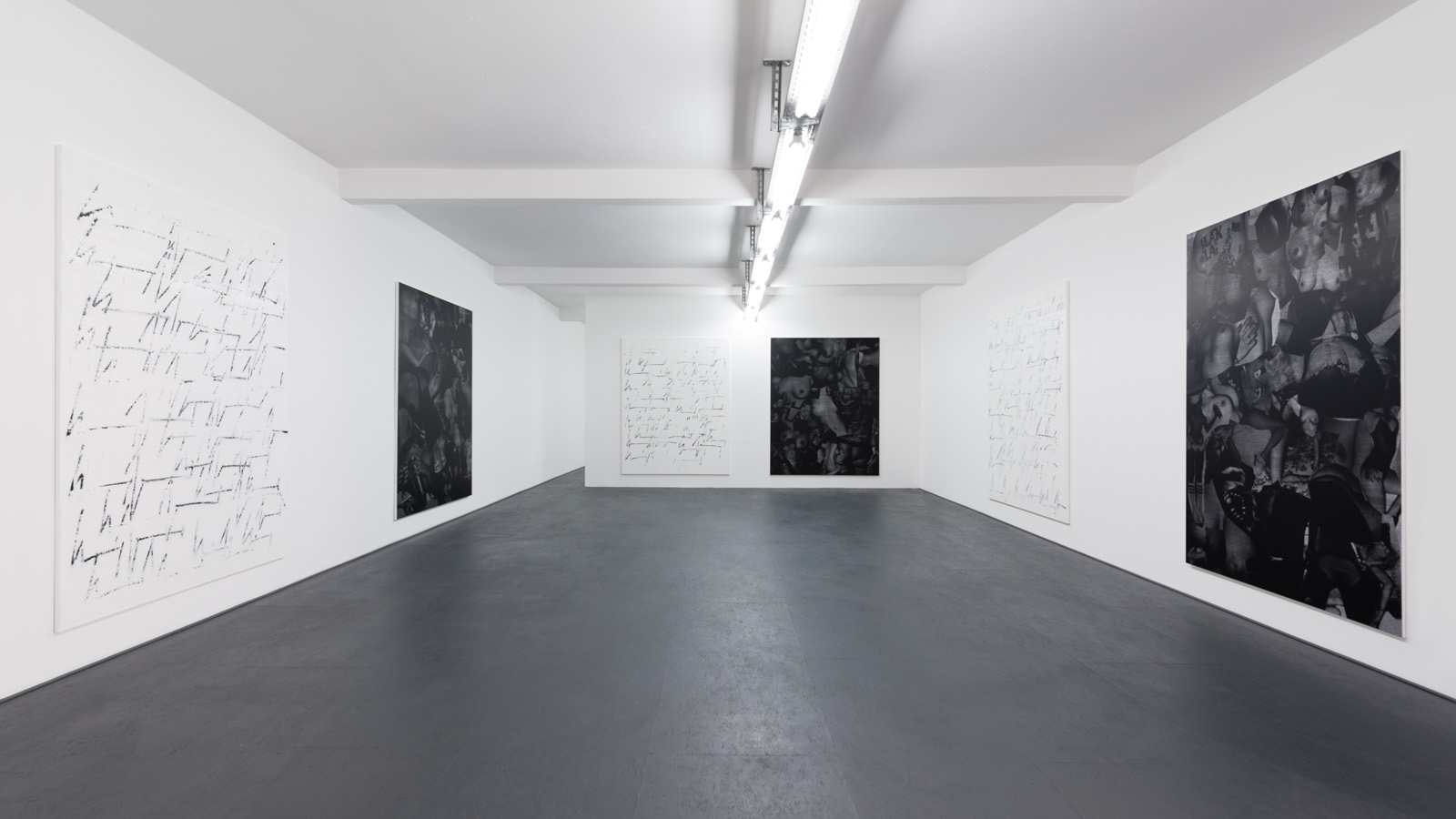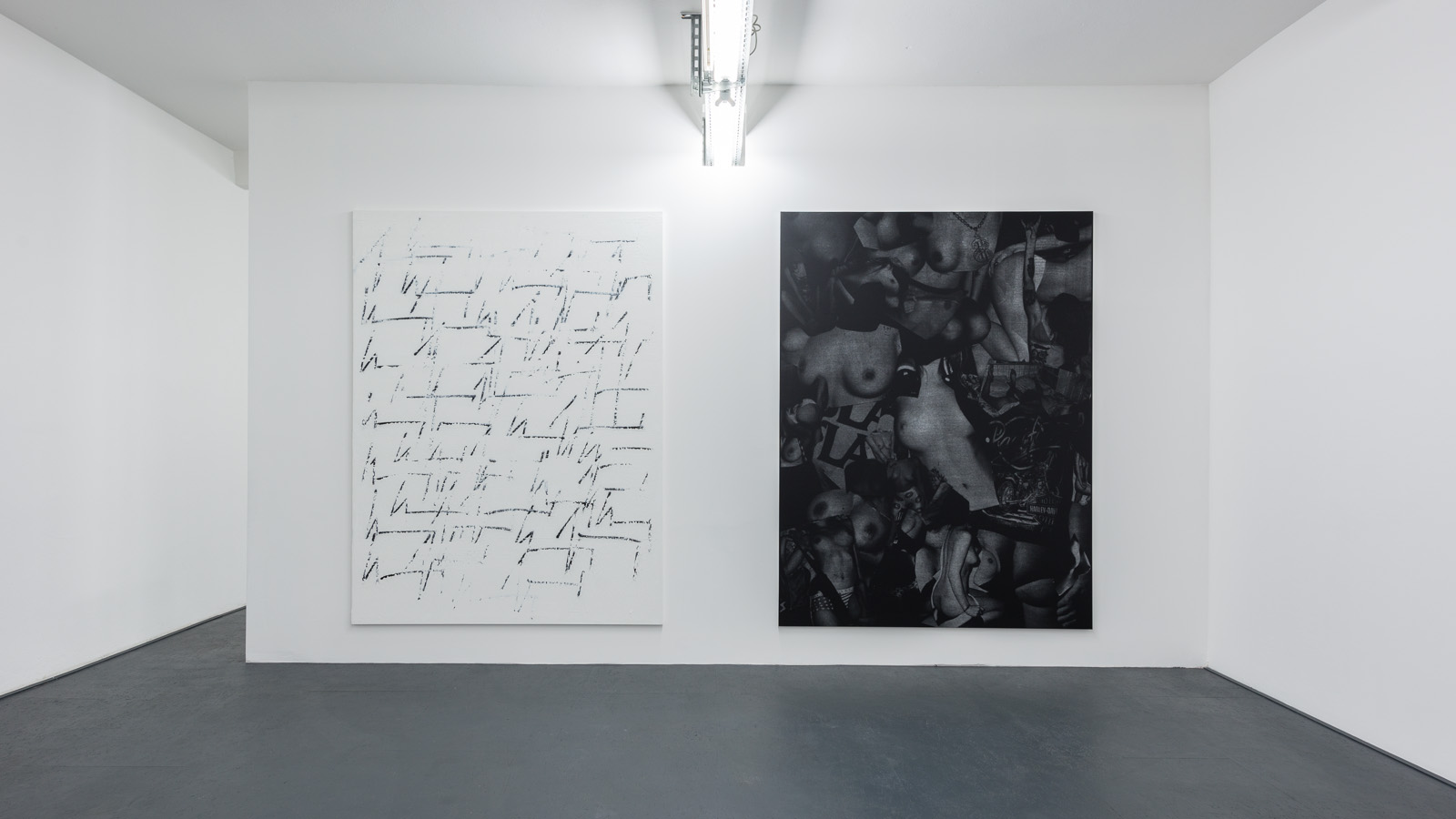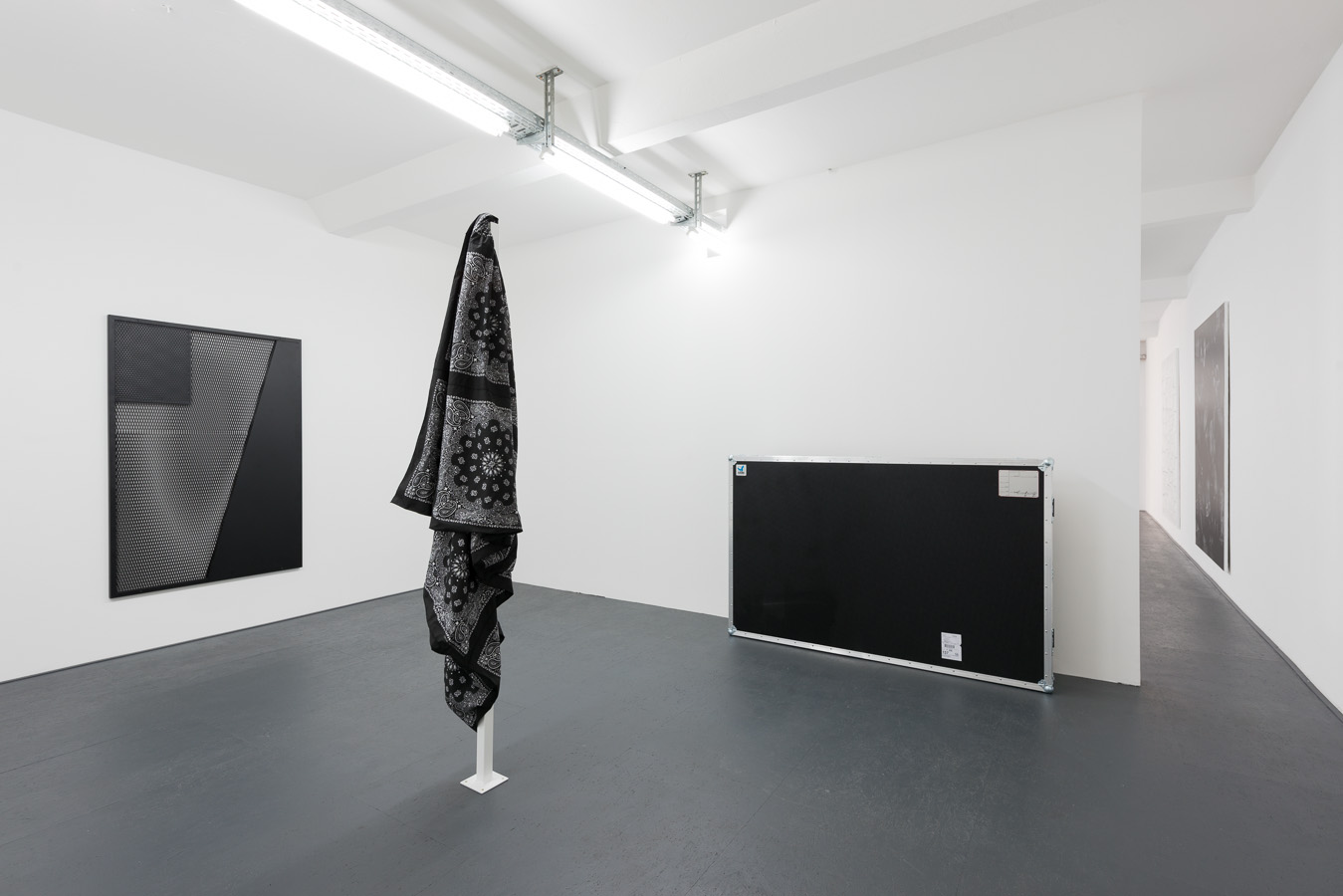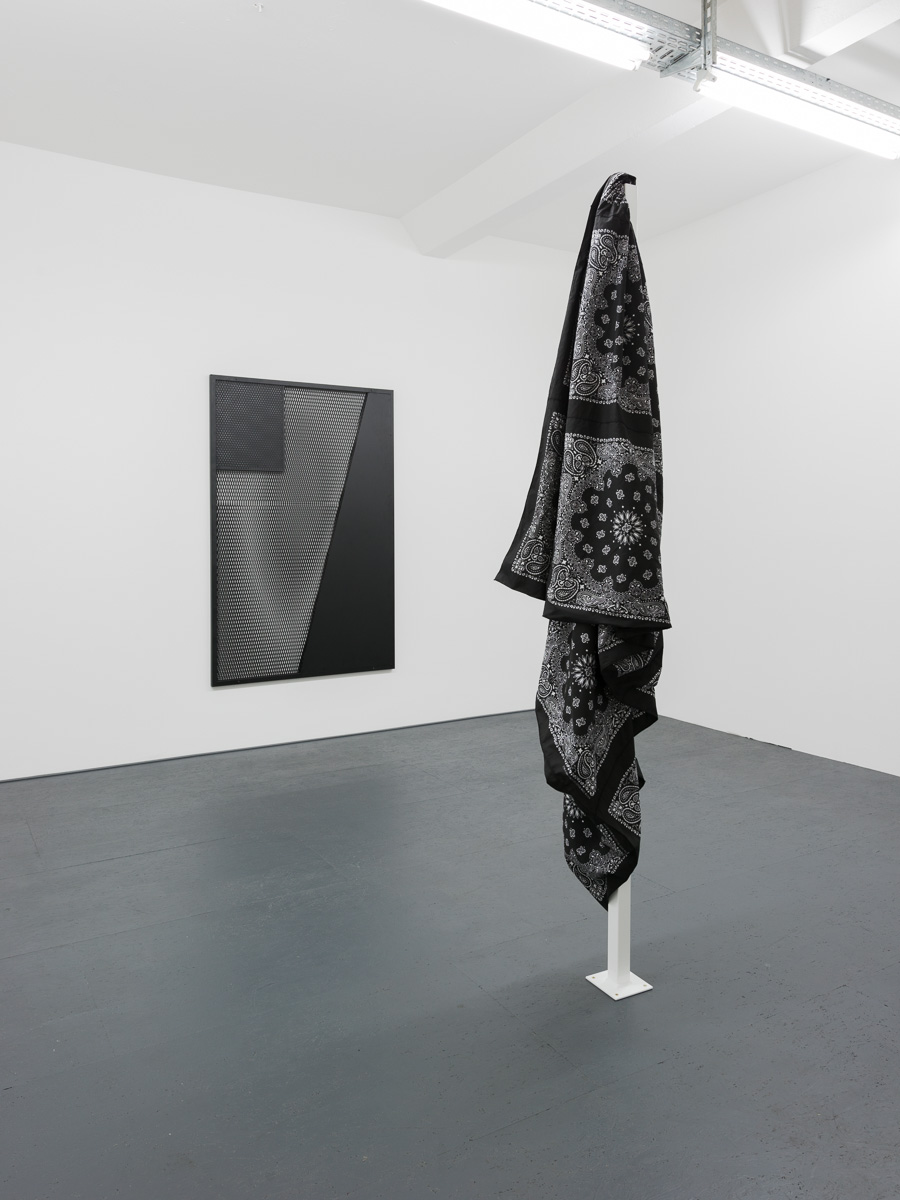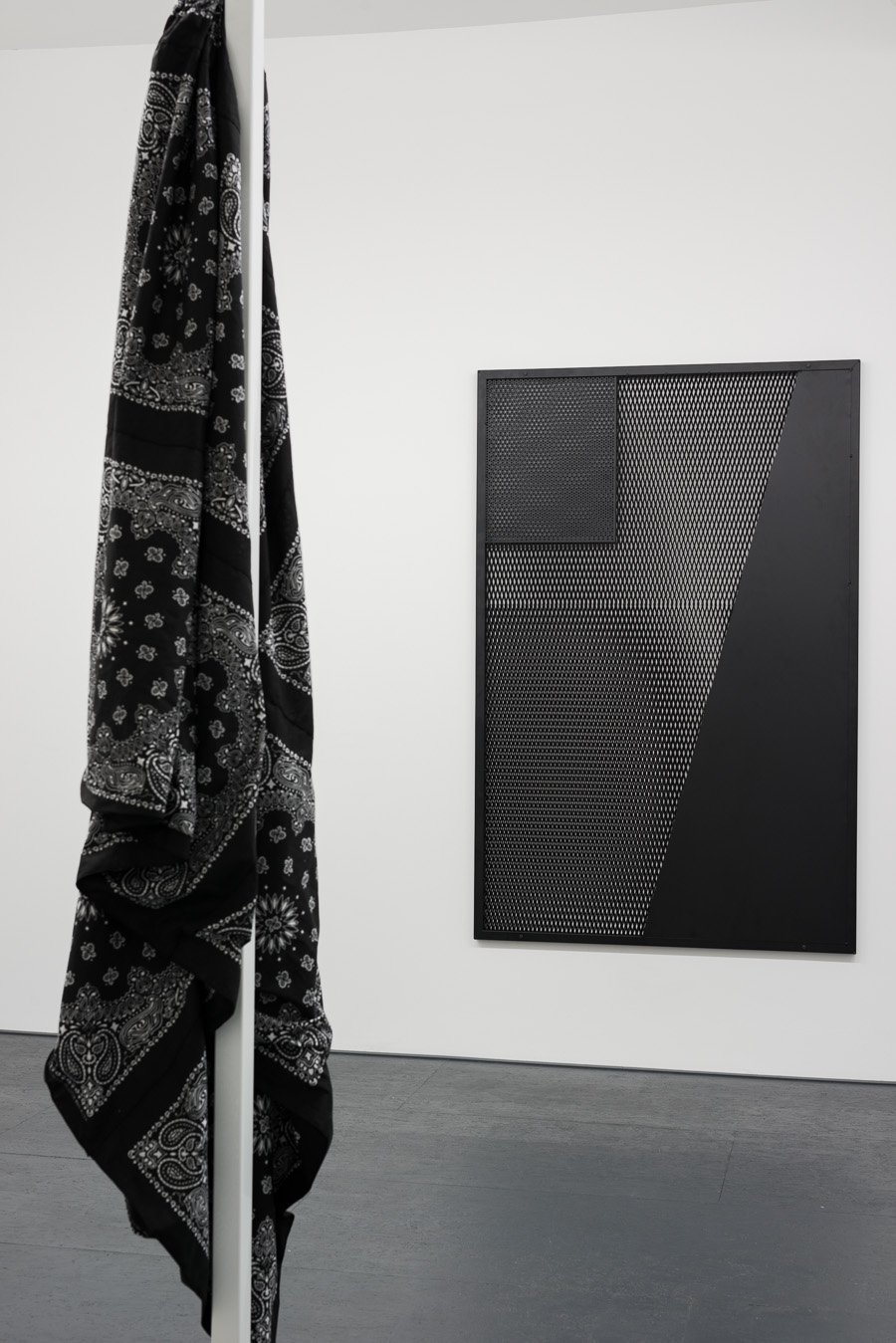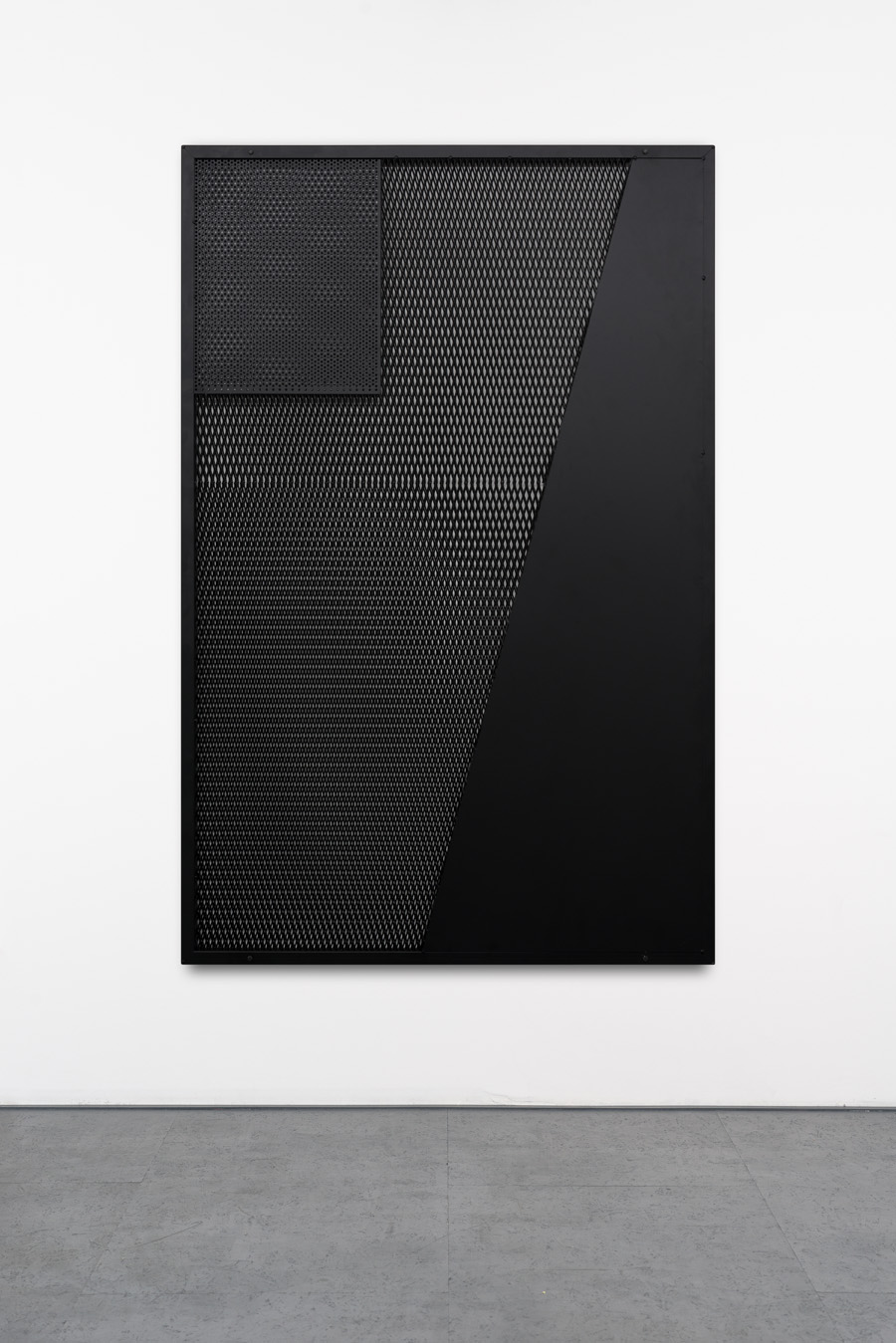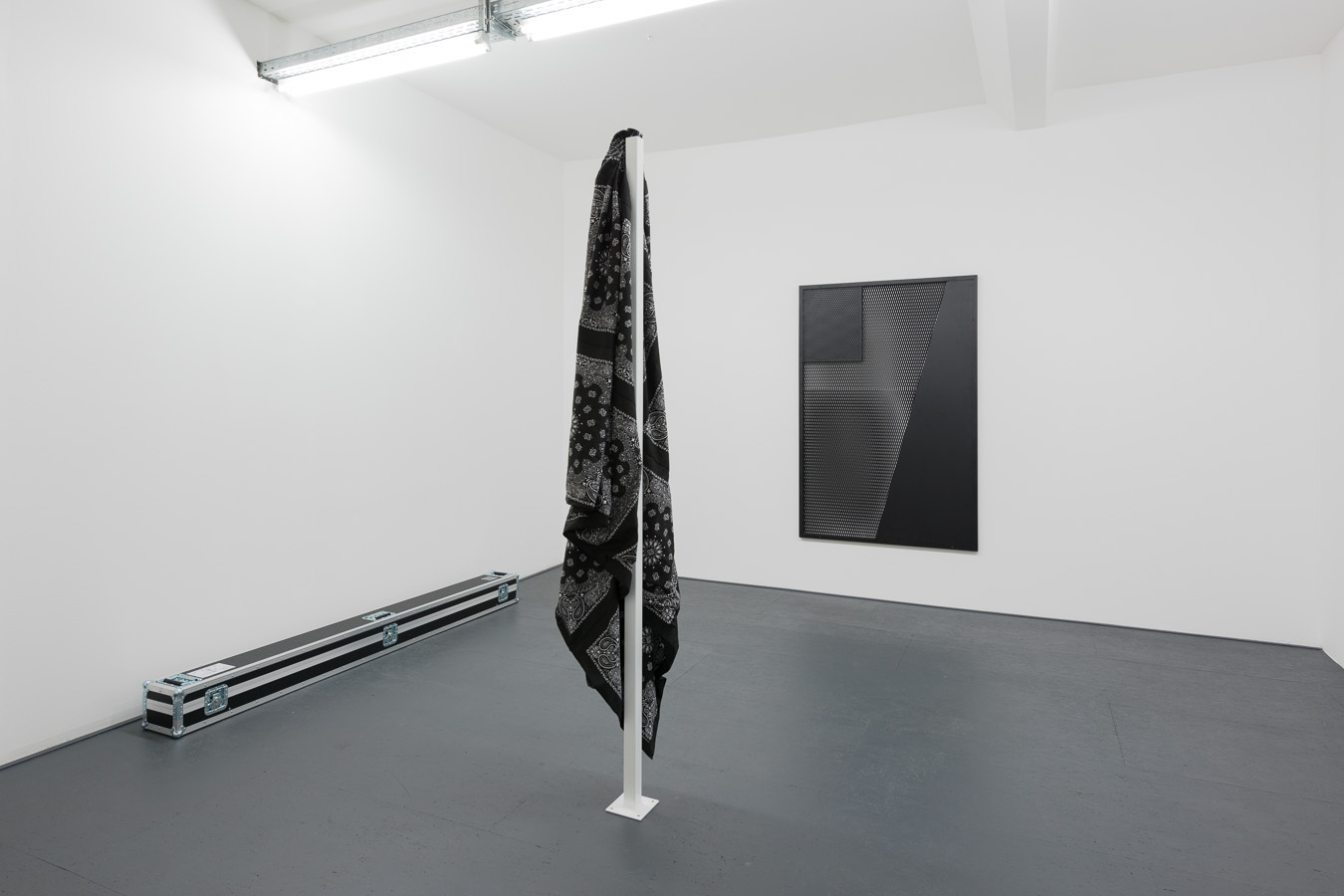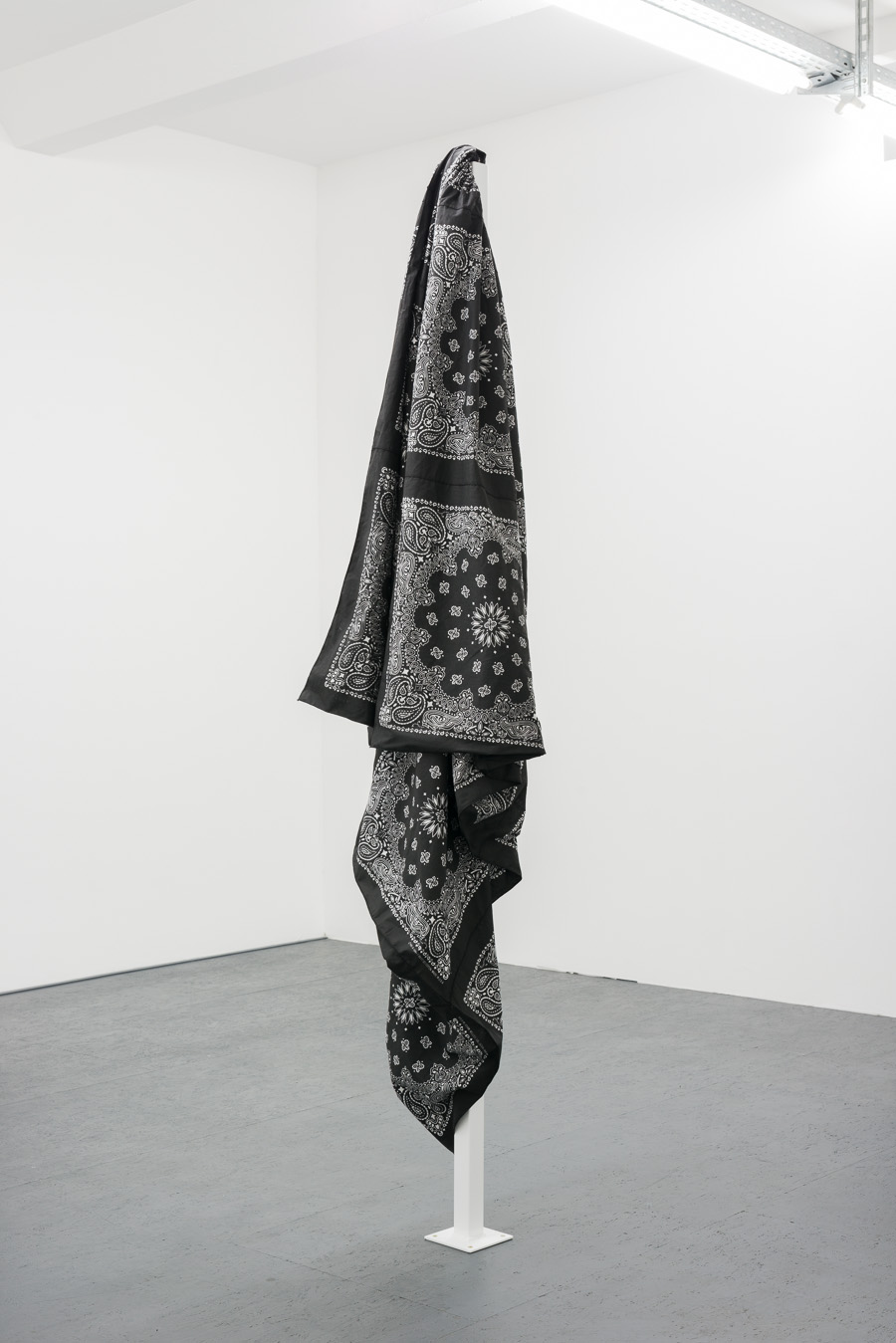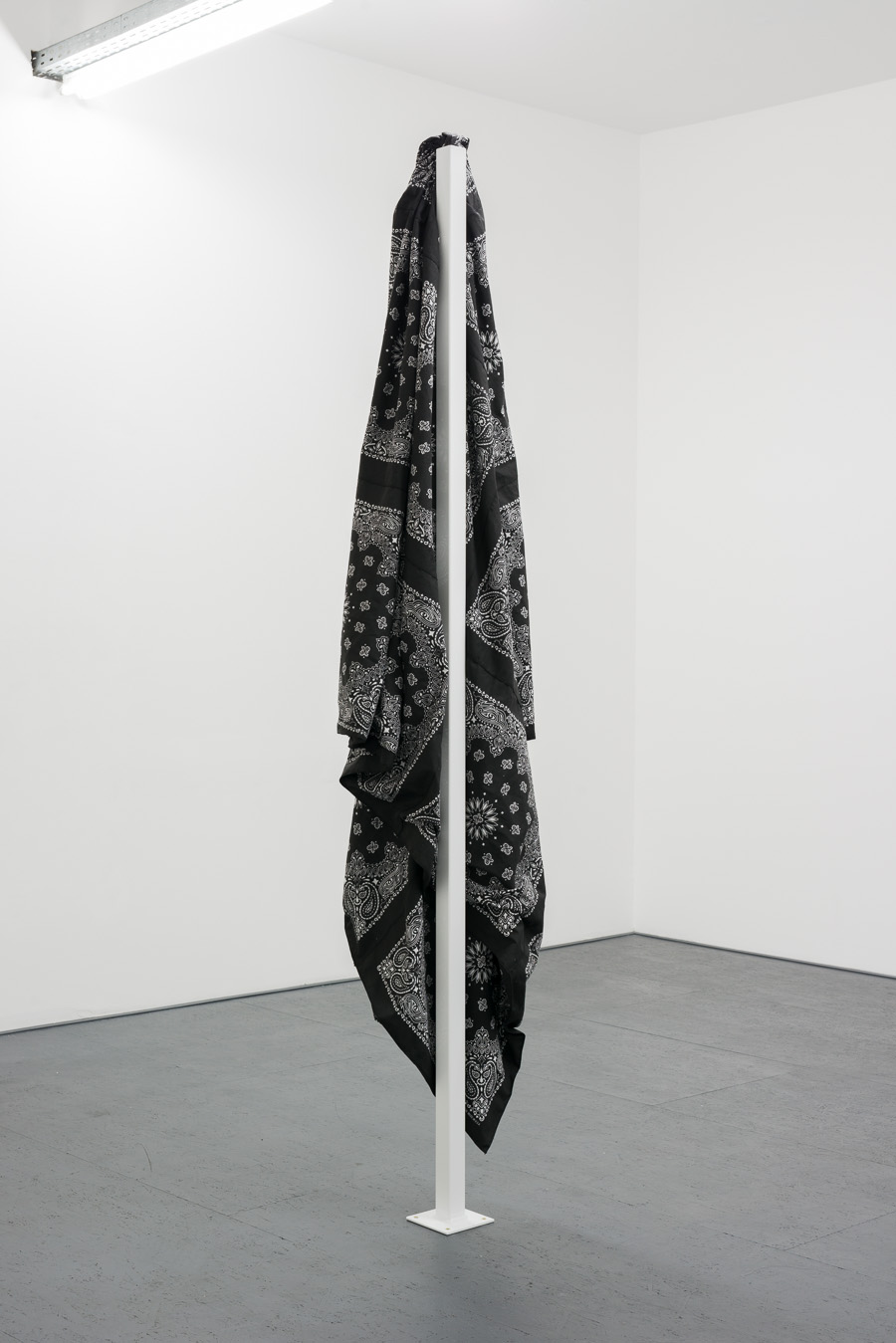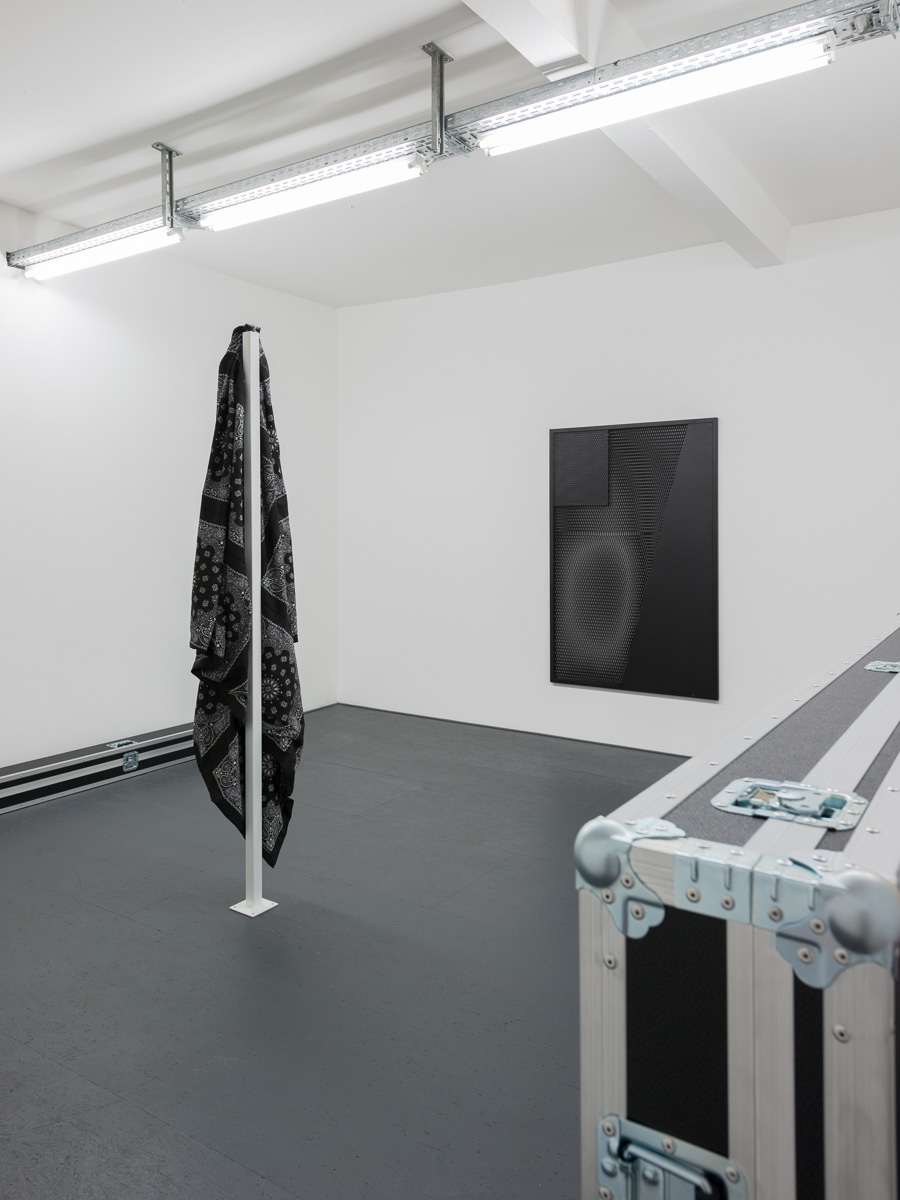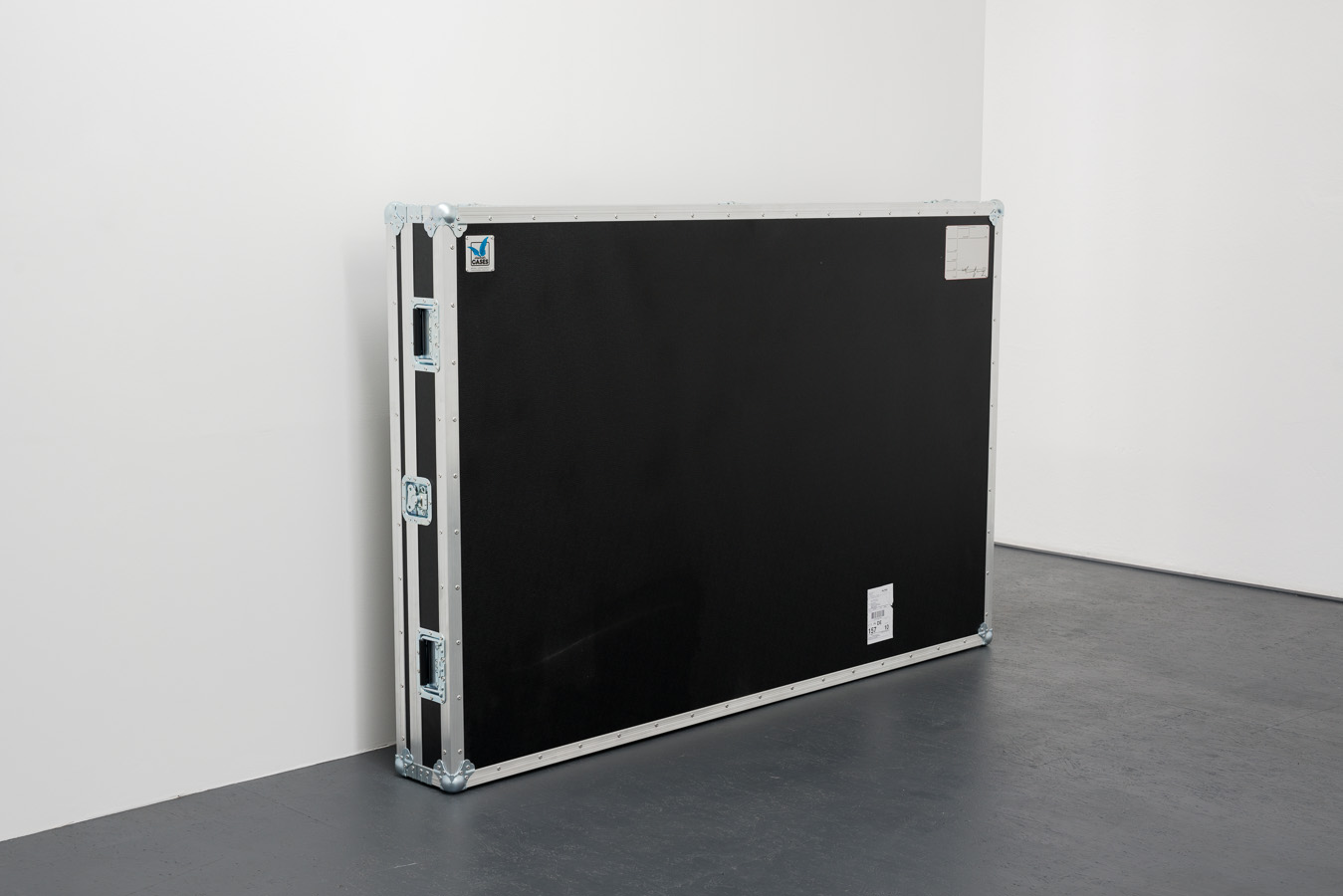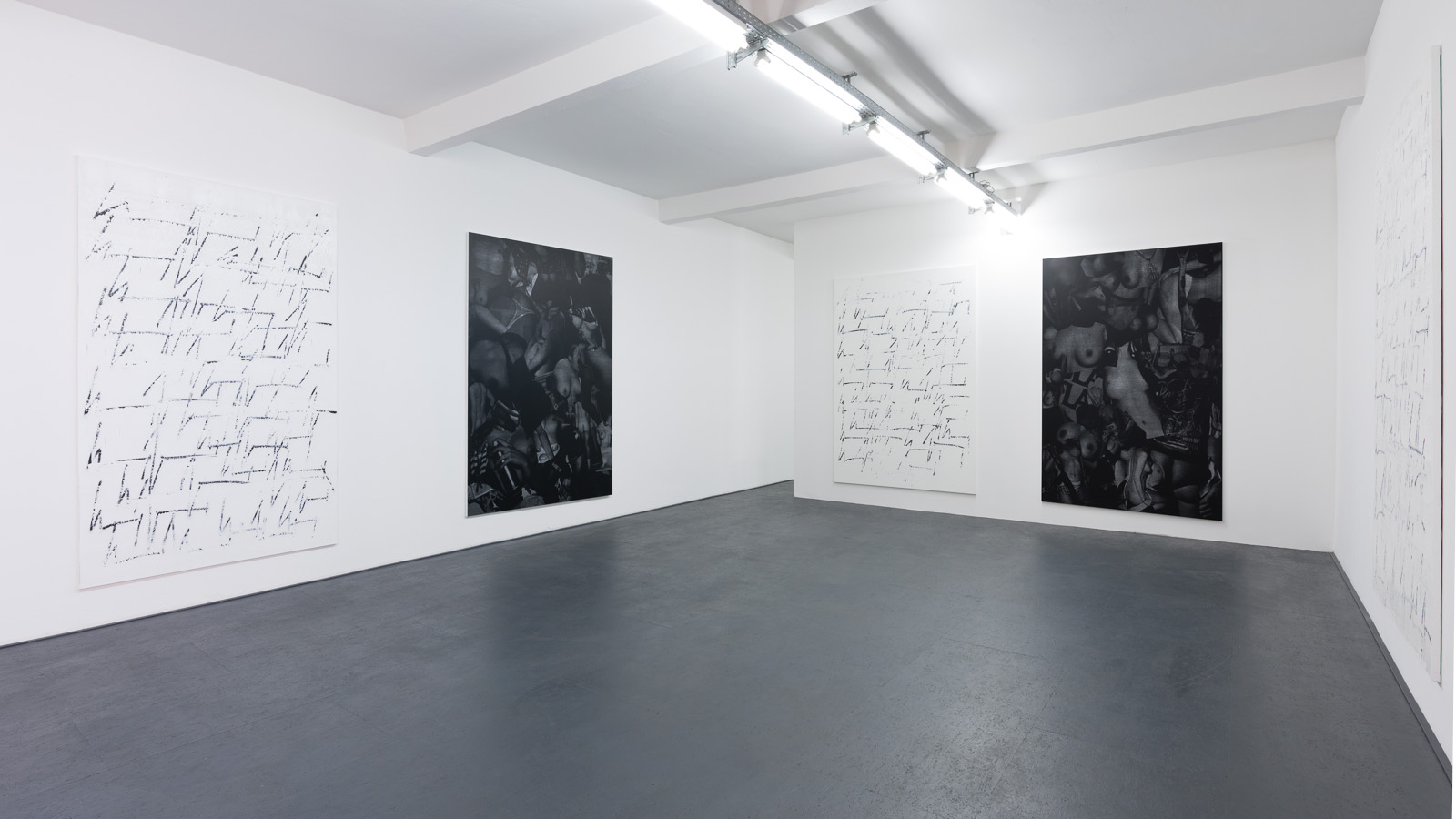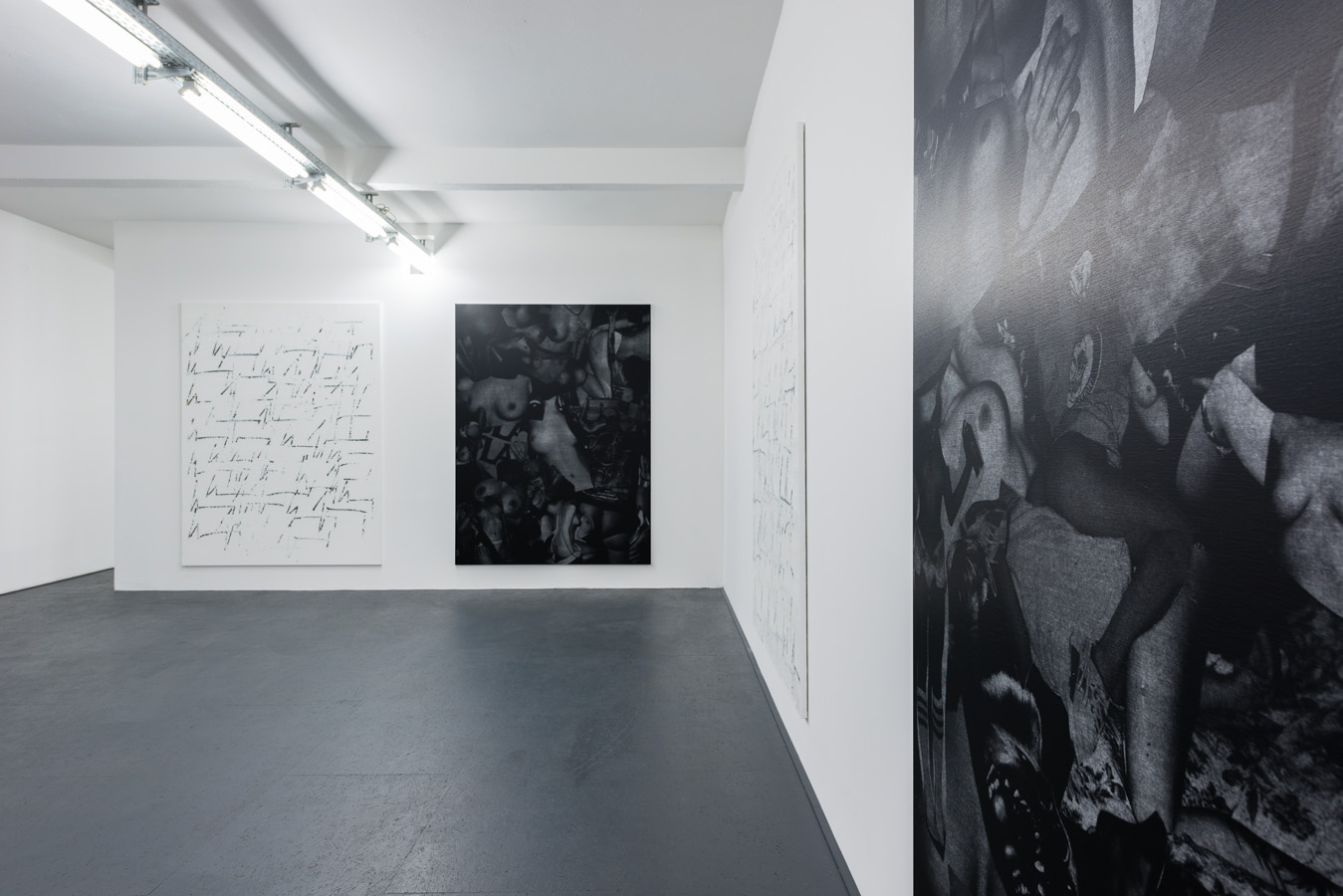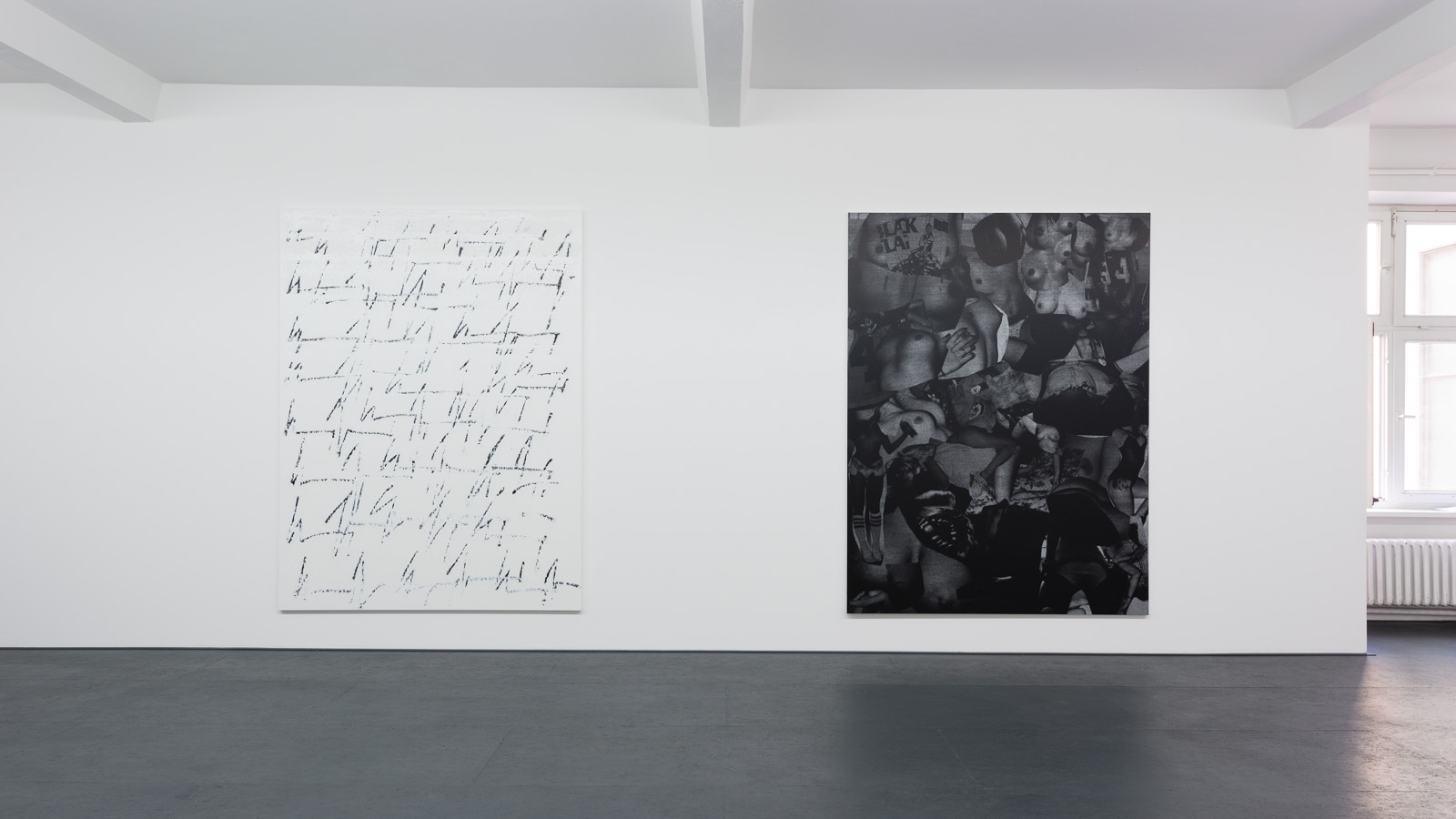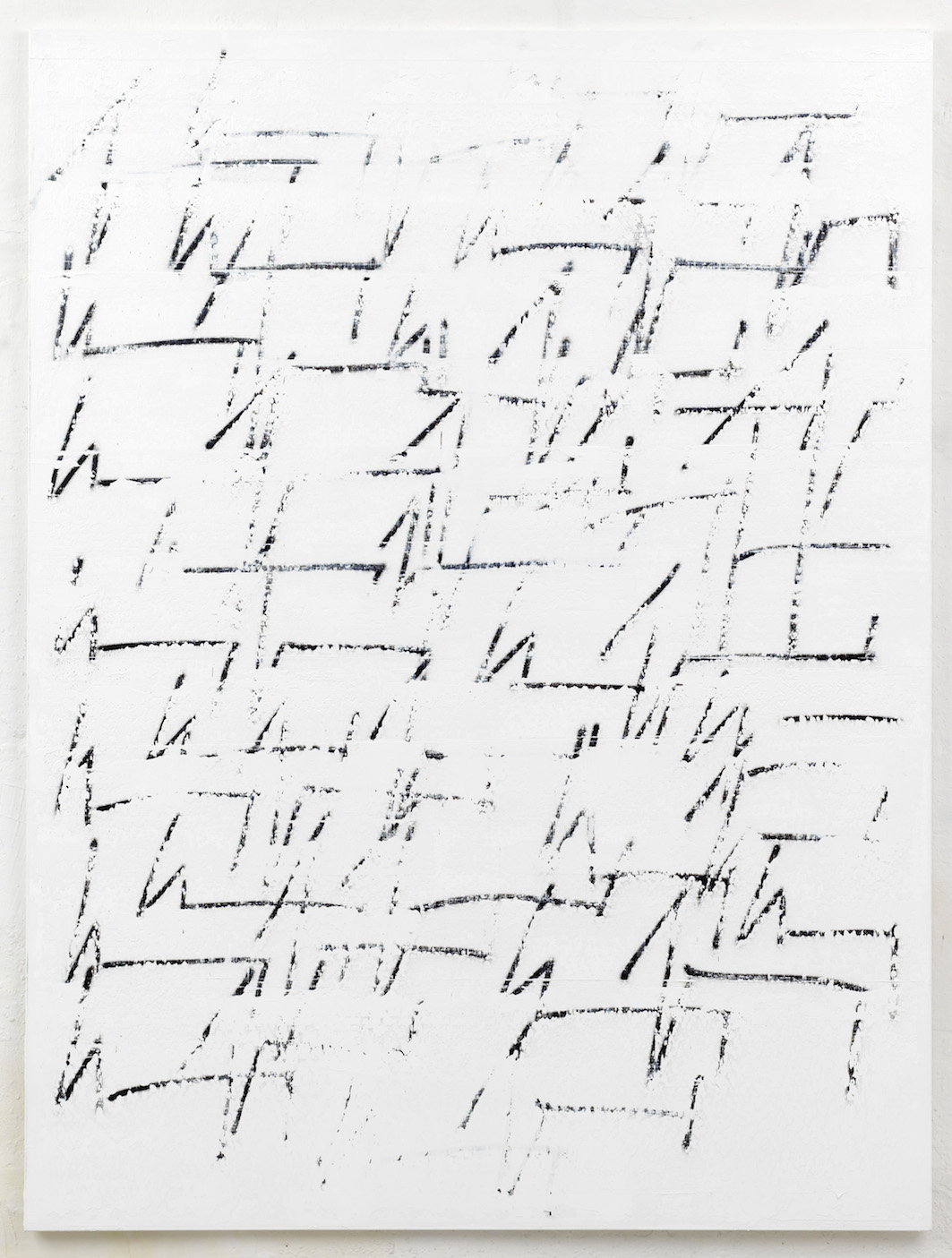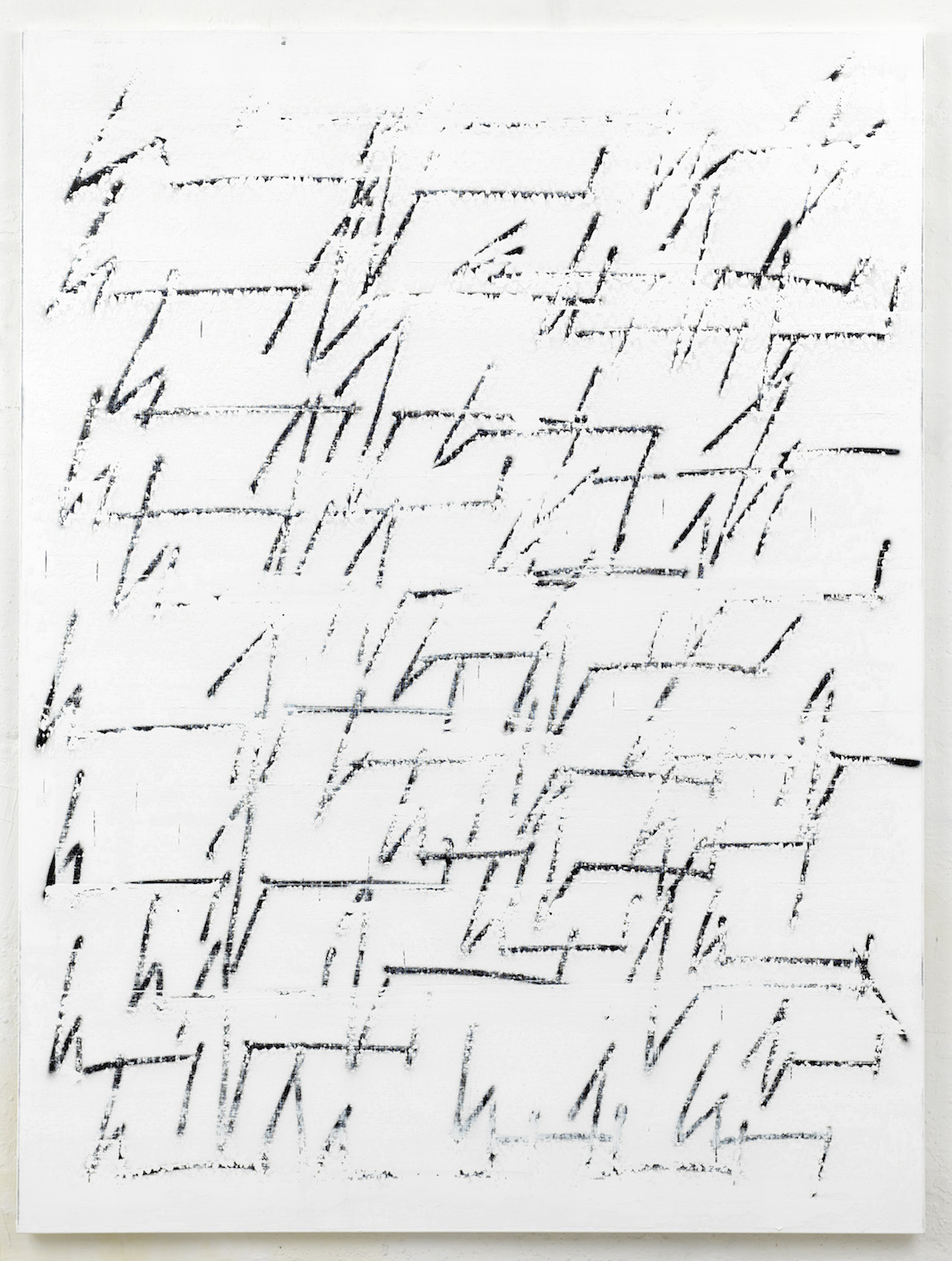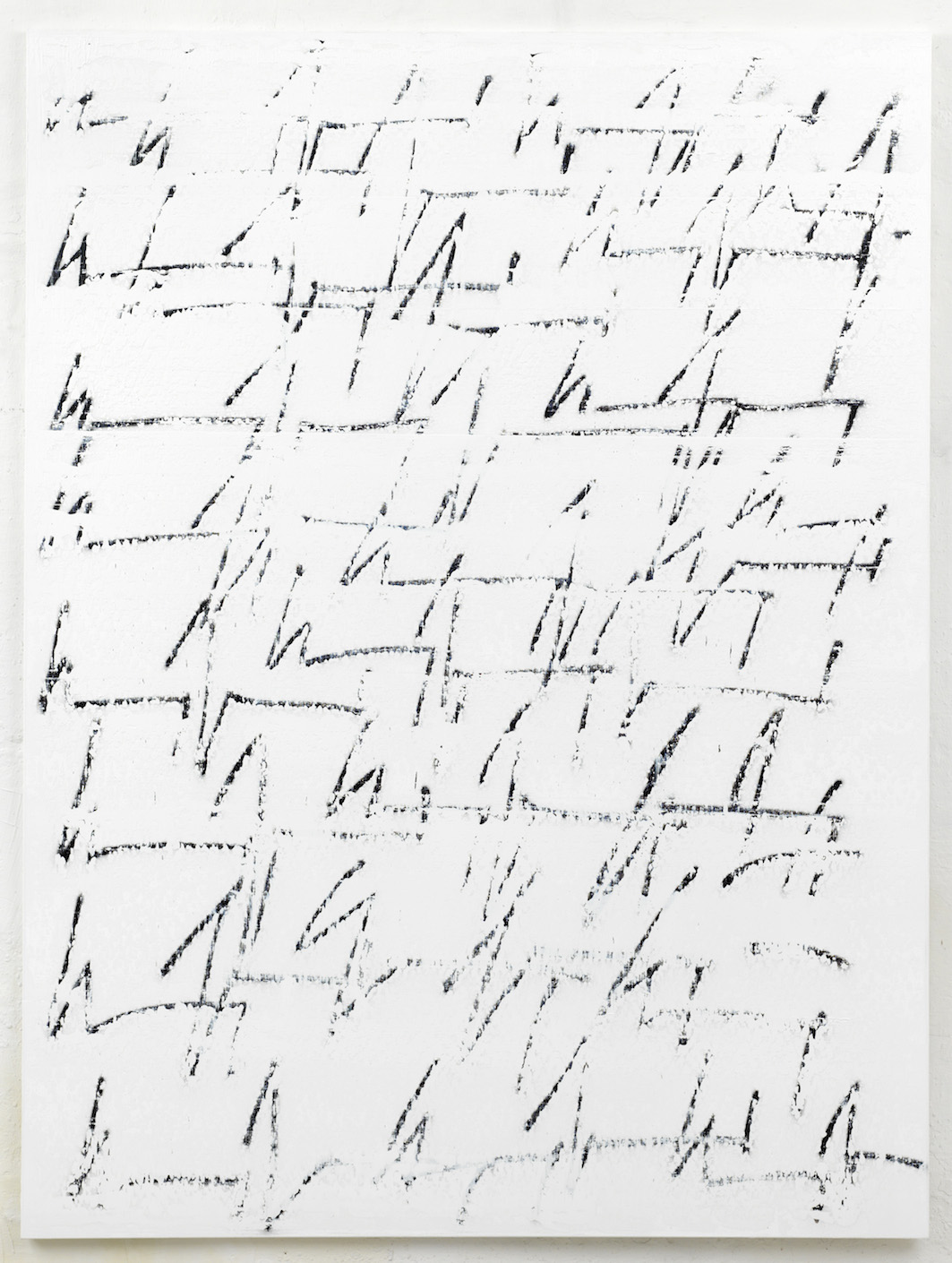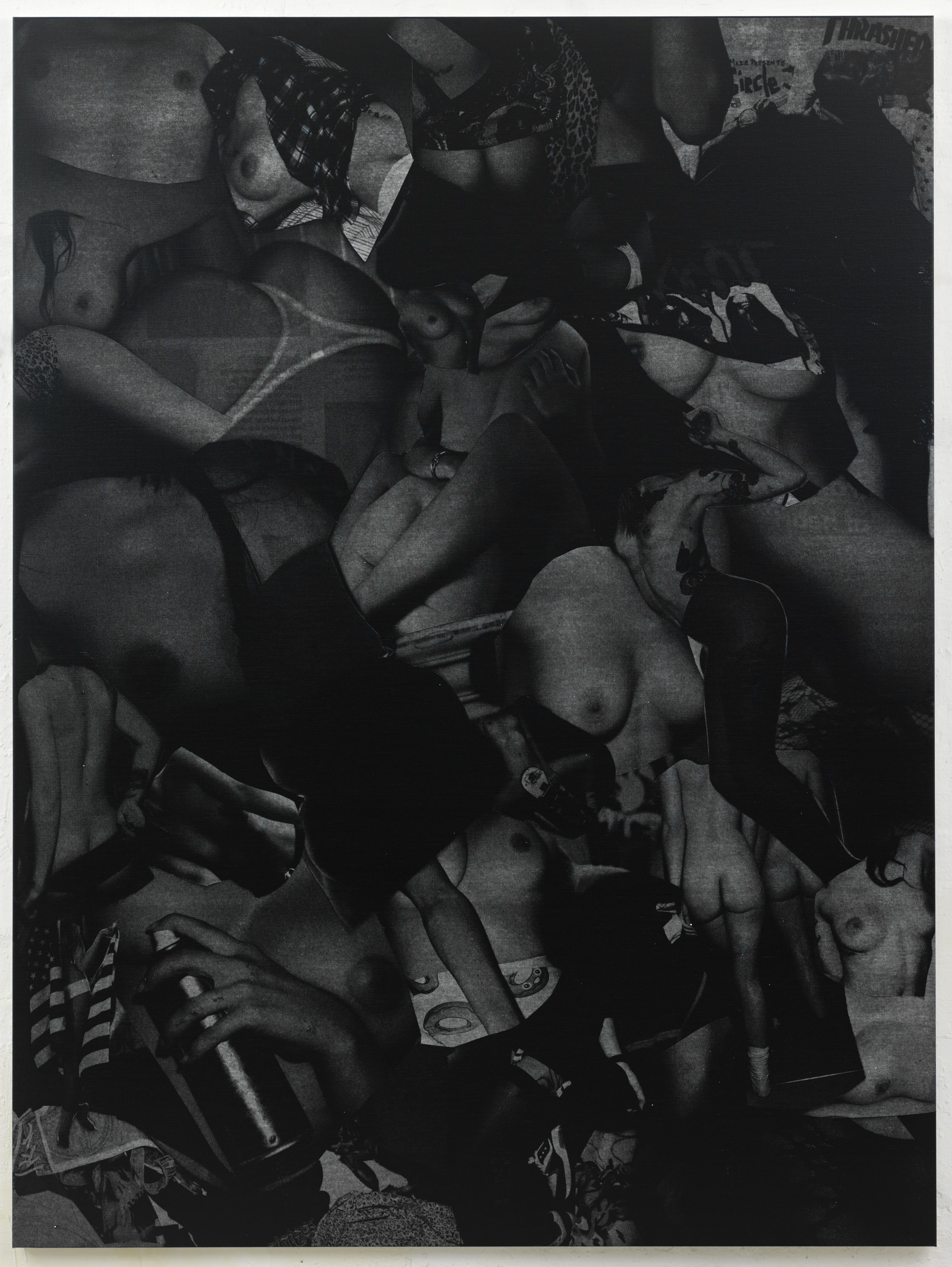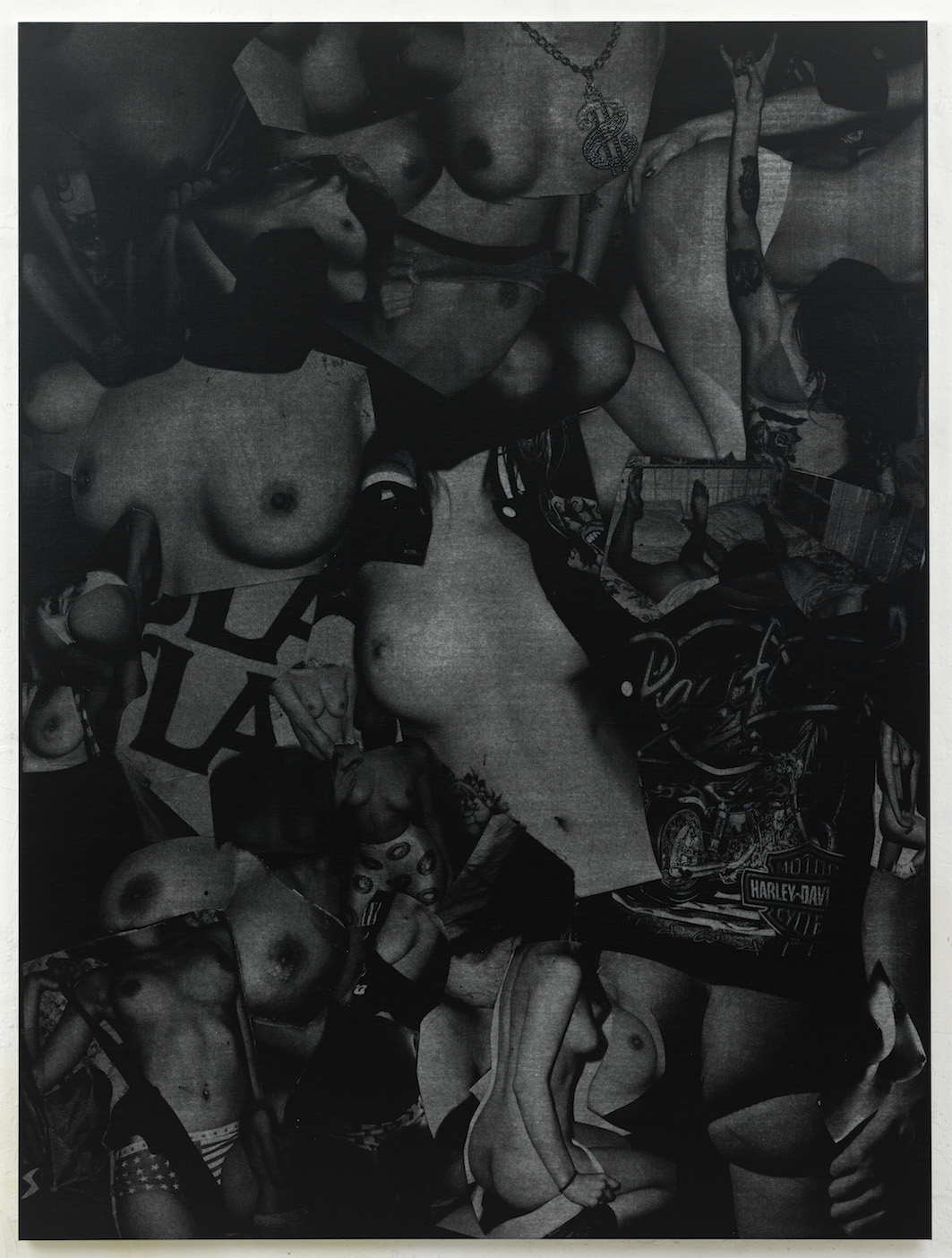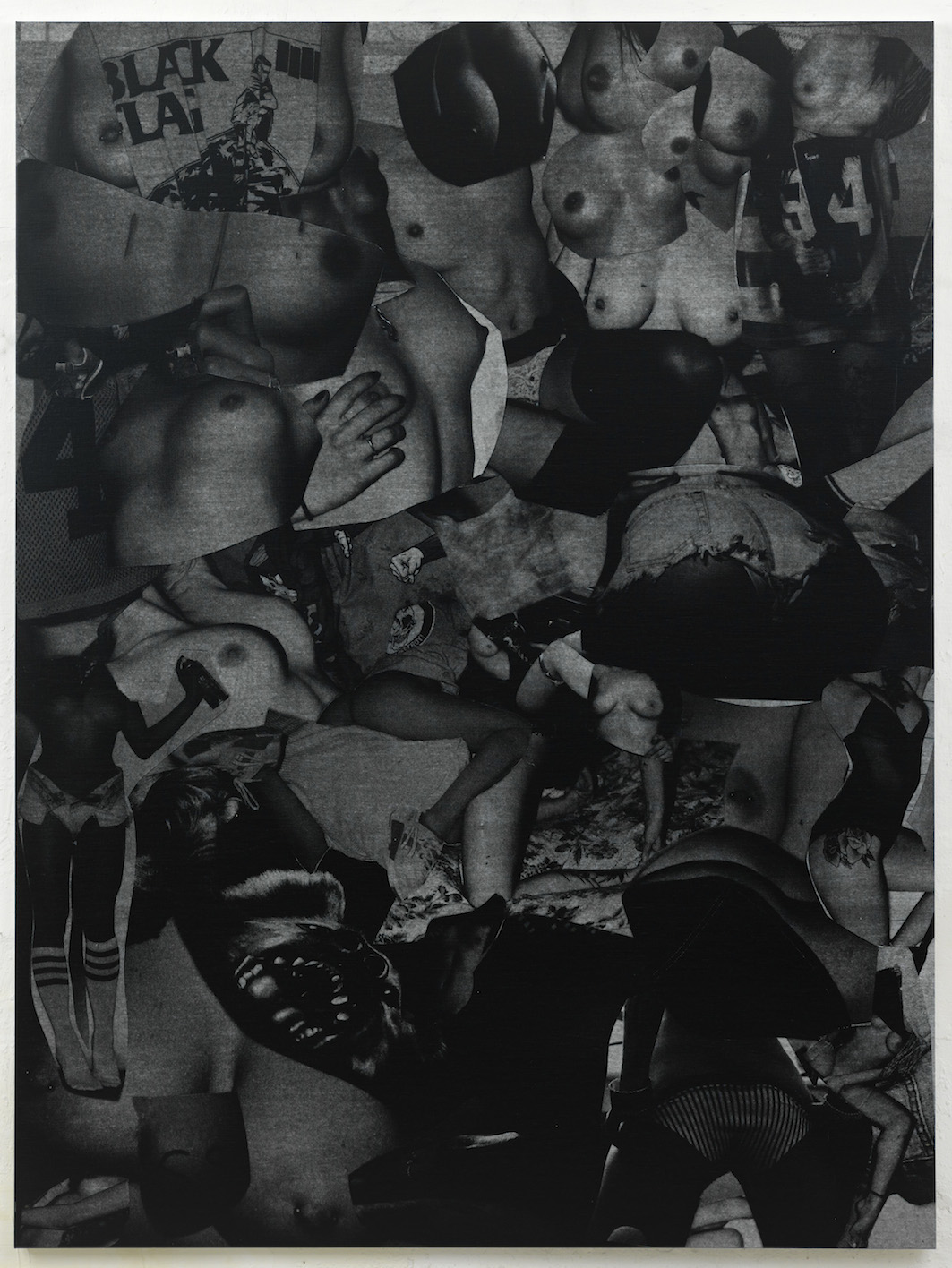CHRIS SUCCO
IMAGES
INFO
In his self-titled solo show at DUVE Berlin, Chris Succo exhibits a pared-down selection of two new bodies of work. At first glance these are yin and yang: the muted, whitewashed RG Paintings deflect any singular meaning through their abstract minimalism and flat formality; whereas the untitled silkscreen paintings – greyscale collages of fractured female nudes – are overloaded with highly literal, figurative content. This one-to-one pairing of works compresses the art historical dichotomy of figuration/abstraction into a flat moment of breakdown within that dual construction. Yin and yang collide, then coalesce.
Through a reductive process, Succo creates each RG painting by carving a jagged line into the surface layer of white paint to reveal the dark pigment beneath. The signage that emerges suggests a hastily scrawled signature, or a signature heartbeat pulsing across an electrocardiograph screen. The wavering line moves like the historical alternation between abstraction and figuration, a horizontal line with spikes at each banal historical turn, and the RG Paintings depict this nothing-time in a pseudo-linguistic gesture – what Roland Barthes would call “the gesture of inscription,” that is, an unvocalized pronouncement, a signature without a name attached.
With Succo’s silkscreen works this implied temporality comes to a halt. Their source material is cut from contemporary photographs, but through their silkscreened reproduction on canvas they gain a vintage aesthetic, flattening past into present. In their resemblance to graphic concert posters, they also reference the aesthetic of self-promotion, indicating the exposure of the body as well as the formal exposure of the image onto the silkscreen. No longer full figures, the exposed images of faceless bodies are truncated, inactive, and objectified. One considers the not-so-dissimilar modes of objectification of the female body in both pop cultural and art historical discourse.
But where is the heartbeat in the collages? Do these bodies have a pulse? The images extend off the sides of the canvas, as if we are simply seeing out a window into an endless sea of identical tits n’ asses. The bodies become landscape rather than figure. The ubiquitousness, and therefore banality, of these would-be intimate photos is overwhelming. Confronted with such nudity alongside the bare white paintings, one considers the banality of the distinction between abstraction and figuration.
Whereas Succo’s previous iterations of monochrome paintings were smeary, chaotic expressions of physicality – thick paint slapped on canvas – this new series tends toward the muted, the calm, the deliberate, and the self-aware. Yet their loud titles – SHAMELESS IS A TALENT, THE WORLD SUCKS IF YOU´RE SHY, and YOU LOOK LIKE NIRVANA JUST BROKE UP – allude to the flip-side of self-reflection, something akin to self-posturing, or a vain preoccupation with one’s own physical expression of emotion, which, like the silkscreens, is a function of self-exposure or fame.
In painting, the body leaves traces on the canvas in the form of the gesture, but in this exhibition this relationship between the bodily act and its trace is so estranged as to become the subject of the work itself. The content of the show hovers between the non-abstract and the non-figurative, in the negative space of the gesture, in the negative space of the body, as intimate as possible and yet as alienated.
- Elvia Wilk
Through a reductive process, Succo creates each RG painting by carving a jagged line into the surface layer of white paint to reveal the dark pigment beneath. The signage that emerges suggests a hastily scrawled signature, or a signature heartbeat pulsing across an electrocardiograph screen. The wavering line moves like the historical alternation between abstraction and figuration, a horizontal line with spikes at each banal historical turn, and the RG Paintings depict this nothing-time in a pseudo-linguistic gesture – what Roland Barthes would call “the gesture of inscription,” that is, an unvocalized pronouncement, a signature without a name attached.
With Succo’s silkscreen works this implied temporality comes to a halt. Their source material is cut from contemporary photographs, but through their silkscreened reproduction on canvas they gain a vintage aesthetic, flattening past into present. In their resemblance to graphic concert posters, they also reference the aesthetic of self-promotion, indicating the exposure of the body as well as the formal exposure of the image onto the silkscreen. No longer full figures, the exposed images of faceless bodies are truncated, inactive, and objectified. One considers the not-so-dissimilar modes of objectification of the female body in both pop cultural and art historical discourse.
But where is the heartbeat in the collages? Do these bodies have a pulse? The images extend off the sides of the canvas, as if we are simply seeing out a window into an endless sea of identical tits n’ asses. The bodies become landscape rather than figure. The ubiquitousness, and therefore banality, of these would-be intimate photos is overwhelming. Confronted with such nudity alongside the bare white paintings, one considers the banality of the distinction between abstraction and figuration.
Whereas Succo’s previous iterations of monochrome paintings were smeary, chaotic expressions of physicality – thick paint slapped on canvas – this new series tends toward the muted, the calm, the deliberate, and the self-aware. Yet their loud titles – SHAMELESS IS A TALENT, THE WORLD SUCKS IF YOU´RE SHY, and YOU LOOK LIKE NIRVANA JUST BROKE UP – allude to the flip-side of self-reflection, something akin to self-posturing, or a vain preoccupation with one’s own physical expression of emotion, which, like the silkscreens, is a function of self-exposure or fame.
In painting, the body leaves traces on the canvas in the form of the gesture, but in this exhibition this relationship between the bodily act and its trace is so estranged as to become the subject of the work itself. The content of the show hovers between the non-abstract and the non-figurative, in the negative space of the gesture, in the negative space of the body, as intimate as possible and yet as alienated.
- Elvia Wilk
In seiner selbstbetitelten Einzelausstellung bei DUVE Berlin zeigt Chris Succo eine abgespeckte Auswahl zweier neuer Werkserien. Auf den ersten Blick sind sie wie Yin und Yang: Durch ihren abstrakten Minimalismus und ihre formale Flachheit entziehen sich die gedämpften, weiß getünchten RG Paintings jeder singulären Interpretation. Die unbetitelten Siebdruckbilder – Graustufen-Collagen verschachtelter weiblicher Akte – sind hingegen mit selbstdeutenden, figurativen Inhalten überlastet. Durch die unmittelbare Paarung der Arbeiten verdichtet sich die kunstgeschichtliche Gegensätzlichkeit von Figuration/Abstraktion für einen Moment und führt zu einem Zerfall innerhalb dieser dualen Konstruktion. Yin und Yang kollidieren, um anschließend zu verschmelzen.
Succo erstellt jedes RG Painting durch ein reduktives Verfahren. Er ritzt gezackte Linien in die Oberflächenschicht weißer Farbe, unter der dunkles Pigment zum Vorschein tritt. Die so entstandenen Zeichen erinnern an hastig hingekritzelte Signaturen oder Ausschläge eines pulsierenden Herzschlages, die über einen EKG-Bildschirm flimmern. Die schlingernde Linie bewegt sich analog zum historischen Wechselspiel zwischen Abstraktion und Figuration – eine horizontale Linie mit Zuspitzungen an jeder banalen historischen Wendung. Die Zeitpunkte zwischen diesen Intervallen werden in den RG Paintings außerdem durch eine pseudo-sprachliche Geste dargestellt, die Roland Barthes als eine „Geste der Einschreibung“ bezeichnen würde – eine unausgesprochene Aussage, eine Signatur ohne dazugehörigen Namen.
Mit Succos Siebdruckarbeiten kommt die implizite Zeitlichkeit zum Stillstand. Ihr Ausgangsmaterial wurde aus zeitgenössischen Fotografien ausgeschnitten. Durch ihre Reproduktion im Siebdruckverfahren wird ihnen allerdings eine Vintage-Ästhetik verliehen; Vergangenheit und Gegenwart werden eingeebnet. In ihrer grafischen Ähnlichkeit zu Konzertplakaten bestehen hier außerdem Bezüge zur Ästhetik der Selbstdarstellung, aus denen sich sowohl die Bloßstellung oder Belichtung des Körpers, als auch die formale Belichtung des Bildes auf den Siebdruck ergibt. Es handelt sich nicht mehr um vollständige Figuren, sondern um die exponierten Bilder gesichtsloser Körper – abgeschnitten, inaktiv und objektiviert. Man kann sich an ähnliche Modalitäten der Objektivierung des weiblichen Körpers in sowohl der Popkultur, als auch im kunsthistorischem Diskurs erinnert fühlen.
Wo aber ist der Herzschlag in diesen Collagen? Haben diese Körper einen Puls? Die Bilder gehen über den Rand der Leinwand hinaus, als würden wir durch eine Art Fenster auf ein endloses Meer identischer Brüste und Hinterteile blicken. Die Körper sind eher Landschaft als Figur. Die Allgegenwart und damit Banalität dieser möchtegern-intimen Fotos ist überwältigend. Mit solcher Nacktheit entlang dieser kahlen weißen Bilder konfrontiert, betrachtet man die Banalität der Unterscheidung zwischen Abstraktion und Figuration.
Handelte es sich bei Succos früheren monochromen Bildserien um verschmierte, chaotische Darstellungen von Körperlichkeit mit dick aufgeklatschter Farbe, neigt diese neue Serie eher zum Gedämpften, Ruhigen, Absichtsvollen und Bewussten. Die lauten Bildtitel, wie etwa SHAMELESS IS A TALENT, THE WORLD SUCKS IF YOU´RE SHY und YOU LOOK LIKE NIRVANA JUST BROKE UP, verweisen auf die Kehrseite der Selbstreflexion, auf so etwas wie Wichtigtuerei oder selbstgefällige Beschäftigung mit dem eigenen körperlichen Ausdruck von Emotion.
In der Malerei hinterlässt der Körper in Form der Geste Spuren auf der Leinwand. In dieser Ausstellung ist die Beziehung zwischen physischem Akt und dessen Spuren allerdings so entfremdet, dass sie zum Gegenstand der Arbeit selbst wird. Inhaltlich schwebt die Schau zwischen dem nicht-Abstrakten und dem nicht-Figurativen, im Negativraum der Geste, im Negativraum des Körpers, so intim wie möglich und dennoch so befremdet.
- Elvia Wilk
Succo erstellt jedes RG Painting durch ein reduktives Verfahren. Er ritzt gezackte Linien in die Oberflächenschicht weißer Farbe, unter der dunkles Pigment zum Vorschein tritt. Die so entstandenen Zeichen erinnern an hastig hingekritzelte Signaturen oder Ausschläge eines pulsierenden Herzschlages, die über einen EKG-Bildschirm flimmern. Die schlingernde Linie bewegt sich analog zum historischen Wechselspiel zwischen Abstraktion und Figuration – eine horizontale Linie mit Zuspitzungen an jeder banalen historischen Wendung. Die Zeitpunkte zwischen diesen Intervallen werden in den RG Paintings außerdem durch eine pseudo-sprachliche Geste dargestellt, die Roland Barthes als eine „Geste der Einschreibung“ bezeichnen würde – eine unausgesprochene Aussage, eine Signatur ohne dazugehörigen Namen.
Mit Succos Siebdruckarbeiten kommt die implizite Zeitlichkeit zum Stillstand. Ihr Ausgangsmaterial wurde aus zeitgenössischen Fotografien ausgeschnitten. Durch ihre Reproduktion im Siebdruckverfahren wird ihnen allerdings eine Vintage-Ästhetik verliehen; Vergangenheit und Gegenwart werden eingeebnet. In ihrer grafischen Ähnlichkeit zu Konzertplakaten bestehen hier außerdem Bezüge zur Ästhetik der Selbstdarstellung, aus denen sich sowohl die Bloßstellung oder Belichtung des Körpers, als auch die formale Belichtung des Bildes auf den Siebdruck ergibt. Es handelt sich nicht mehr um vollständige Figuren, sondern um die exponierten Bilder gesichtsloser Körper – abgeschnitten, inaktiv und objektiviert. Man kann sich an ähnliche Modalitäten der Objektivierung des weiblichen Körpers in sowohl der Popkultur, als auch im kunsthistorischem Diskurs erinnert fühlen.
Wo aber ist der Herzschlag in diesen Collagen? Haben diese Körper einen Puls? Die Bilder gehen über den Rand der Leinwand hinaus, als würden wir durch eine Art Fenster auf ein endloses Meer identischer Brüste und Hinterteile blicken. Die Körper sind eher Landschaft als Figur. Die Allgegenwart und damit Banalität dieser möchtegern-intimen Fotos ist überwältigend. Mit solcher Nacktheit entlang dieser kahlen weißen Bilder konfrontiert, betrachtet man die Banalität der Unterscheidung zwischen Abstraktion und Figuration.
Handelte es sich bei Succos früheren monochromen Bildserien um verschmierte, chaotische Darstellungen von Körperlichkeit mit dick aufgeklatschter Farbe, neigt diese neue Serie eher zum Gedämpften, Ruhigen, Absichtsvollen und Bewussten. Die lauten Bildtitel, wie etwa SHAMELESS IS A TALENT, THE WORLD SUCKS IF YOU´RE SHY und YOU LOOK LIKE NIRVANA JUST BROKE UP, verweisen auf die Kehrseite der Selbstreflexion, auf so etwas wie Wichtigtuerei oder selbstgefällige Beschäftigung mit dem eigenen körperlichen Ausdruck von Emotion.
In der Malerei hinterlässt der Körper in Form der Geste Spuren auf der Leinwand. In dieser Ausstellung ist die Beziehung zwischen physischem Akt und dessen Spuren allerdings so entfremdet, dass sie zum Gegenstand der Arbeit selbst wird. Inhaltlich schwebt die Schau zwischen dem nicht-Abstrakten und dem nicht-Figurativen, im Negativraum der Geste, im Negativraum des Körpers, so intim wie möglich und dennoch so befremdet.
- Elvia Wilk

